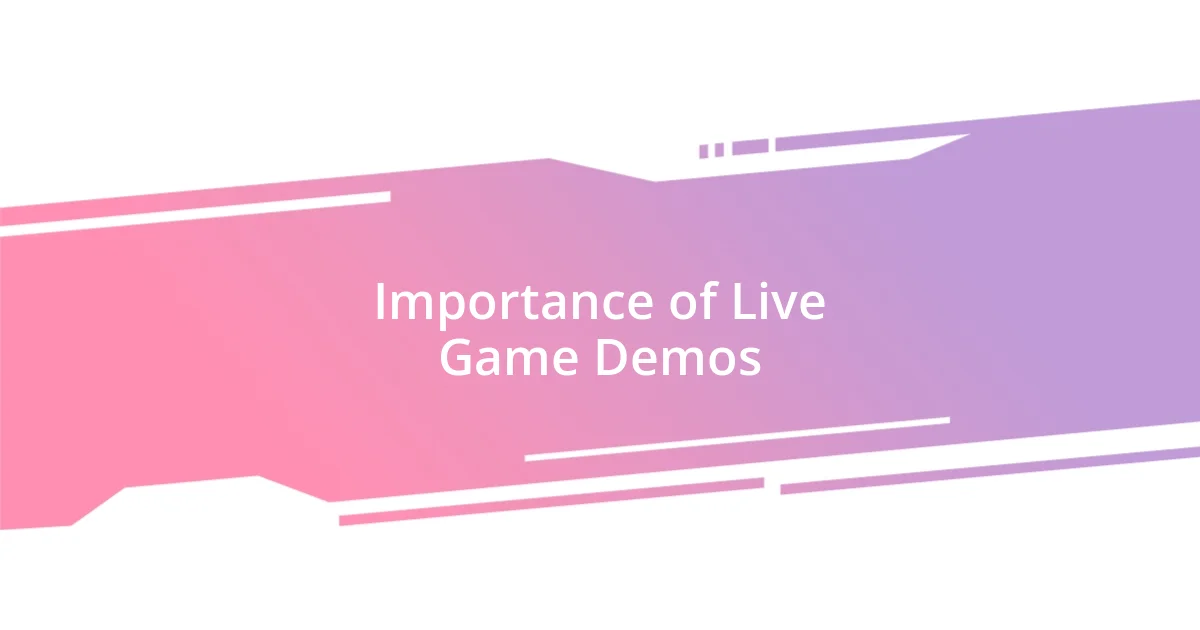Key takeaways:
- Live game demos provide real-time feedback and community engagement, making gamers feel involved in the development process.
- Key features of successful demos include high-quality gameplay, active audience interaction, and dynamic presentation styles that enhance viewer enjoyment.
- Analyzing gameplay mechanics during demos reveals insights into the game’s design and enhances anticipation for its release.

Introduction to Live Game Demos
Live game demos have become a pivotal experience for both developers and gamers alike. I still remember the first time I tuned into a live demo stream; it felt like being part of an exclusive club, where the excitement was palpable. Watching the developers play their game, I couldn’t help but wonder about the creative challenges they faced and the behind-the-scenes decisions that shaped the gameplay.
Participating in these live demos often feels like a window into the heart of game development. They aren’t just promotional tools; they foster a sense of community by inviting viewers to engage in real-time discussions. I recall interacting with other viewers and asking questions like, “How did you come up with that character design?” It was thrilling to see developers respond and share their thought processes. It made me feel more connected to the game and the people behind it.
What I find particularly fascinating is the interplay of feedback during these demos. The instant reactions from the audience can influence the final product, and I’ve seen developers note suggestions on the fly. It feels like we, as gamers, have a seat at the table in shaping the gaming experience. Isn’t it incredible how a simple demo can transform into a collaborative effort?

Importance of Live Game Demos
Live game demos hold significant value in today’s gaming landscape. They offer a front-row seat to the creative process, allowing fans like myself to witness firsthand the evolution of a game. The thrill of seeing a developer tackle a formidable boss fight live is unforgettable, and I often find myself cheering alongside fellow viewers, feeling as if we’re all part of a shared adventure.
Some key reasons why live game demos are crucial include:
- Real-Time Feedback: Developers receive immediate responses that can shape their decisions, making us feel like active participants in the game’s development.
- Community Building: Through live chats and interactions, a community of players and creators forms, enhancing camaraderie among gamers.
- Transparency in Development: These demos demystify the development process, showcasing the hard work that goes into creating a game and making it more relatable.
- Excitement and Anticipation: Watching a game come to life generates buzz and eagerness, turning casual observers into enthusiastic fans.
Experiencing a live demo often feels like a rollercoaster; the thrill of potential bugs adds to the excitement, creating shared moments of joy and frustration. I once watched a developer struggle with a glitch during a tense gameplay moment. Instead of frustration, the chat erupted with encouragement. That moment exemplified how live demos can create a bond that transcends the screen. It’s a reminder that gaming isn’t just about the games—we’re in this together, sharing the highs and lows.

Key Features to Look For
Live game demos are packed with features that enhance the spectator experience. One of the most important aspects is the quality of the gameplay itself. I’ve attended sessions where the graphics were jaw-dropping, pulling me into the game’s universe. In contrast, I’ve also witnessed demos where poor performance marred the experience, leaving me disappointed. The technical performance—frame rates, resolution, and responsiveness—can radically change how real-time gameplay feels, both for viewers and developers.
Another critical feature to look for is audience interaction. I’ve greatly appreciated when developers actively engage with the livestream chat, responding to questions and comments. It’s much more rewarding than one-sided presentations. I once watched a developer pause to address a viewer’s suggestion, integrating it into the demo on the spot. This kind of interaction not only makes the audience feel valued but can also lead to meaningful tweaks in the game, thus empowering viewers to contribute to the creative process.
Lastly, the presentation style can set a live demo apart. I recall a particularly engaging showcase where the developer’s personality shined through the presentation. A good sense of humor and storytelling skills can create an unforgettable experience, just like in any great video game. In contrast, bland or overly scripted demos can fall flat, making it easy to tune out. So, a dynamic and relatable presenter can elevate the entire demo experience.
| Feature | Importance |
|---|---|
| Gameplay Quality | Direct impact on viewer immersion and satisfaction. |
| Audience Interaction | Enhances engagement and can lead to real-time game adjustments. |
| Presentation Style | A captivating presenter can make the demo more enjoyable and memorable. |

Analyzing Gameplay and Mechanics
Analyzing the gameplay and mechanics during live demos often unveils the true essence of a game. I remember watching a demo of an action-adventure game where the fluidity of the combat system left me in awe. The way the character seamlessly transitioned between attacks highlighted a level of polish that set high expectations for its release. It made me wonder—how many iterations did they go through to achieve such smooth gameplay?
One particular element that stands out is the ability to experience mechanics in real time. There was a moment in one demo when the developer showcased a puzzle-solving mechanic that required quick thinking under pressure. Watching them navigate through challenges not only entertained me but also gave me profound insights into the game’s structure. It was as if I were in the developer’s shoes, feeling the tension and excitement they faced.
Additionally, observing the interaction between gameplay and environmental elements can be truly captivating. During a recent demo, a developer illustrated how weather patterns affected gameplay, adding layers of strategy I hadn’t anticipated. It got me thinking—how much more immersive does this make the player experience? For me, these nuances are what elevate a game from good to exceptional.

Conclusion and Recommendations
When reflecting on my experiences with live game demos, I believe they can offer an intriguing peek behind the curtain of game design. I recommend seeking out sessions that emphasize both visual and technical quality. The thrill of high-quality graphics combined with seamless gameplay can truly hook you in, almost transporting you into another world. Isn’t it fascinating how a well-rendered scene can impact our perception of a game?
It’s also crucial to prioritize events where developers engage with the audience. I’ve seen firsthand how a simple comment from a viewer can morph into a thrilling game feature mid-demo. This kind of interaction fosters a sense of community and makes the viewing experience much more enjoyable. If you’re watching a live demo, don’t hesitate to participate; your input could be a game-changer!
Lastly, I’d highly recommend keeping an eye on the presenter’s style. In one demo I watched, the developer’s humor and storytelling ability turned an informative session into a captivating narrative. A dynamic presentation can make all the difference, transforming potential information overload into an unforgettable experience. What makes a great game presentation for you? Embrace the ones that resonate with you, and you’ll find yourself not just watching, but truly experiencing the game.














